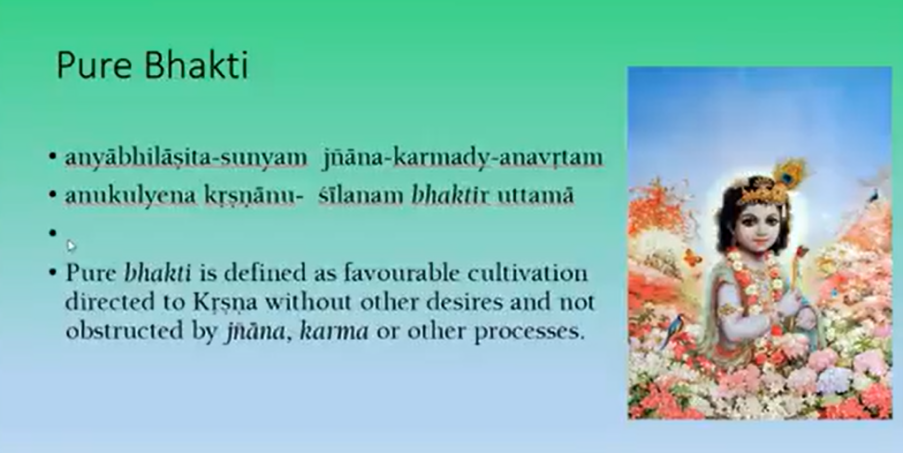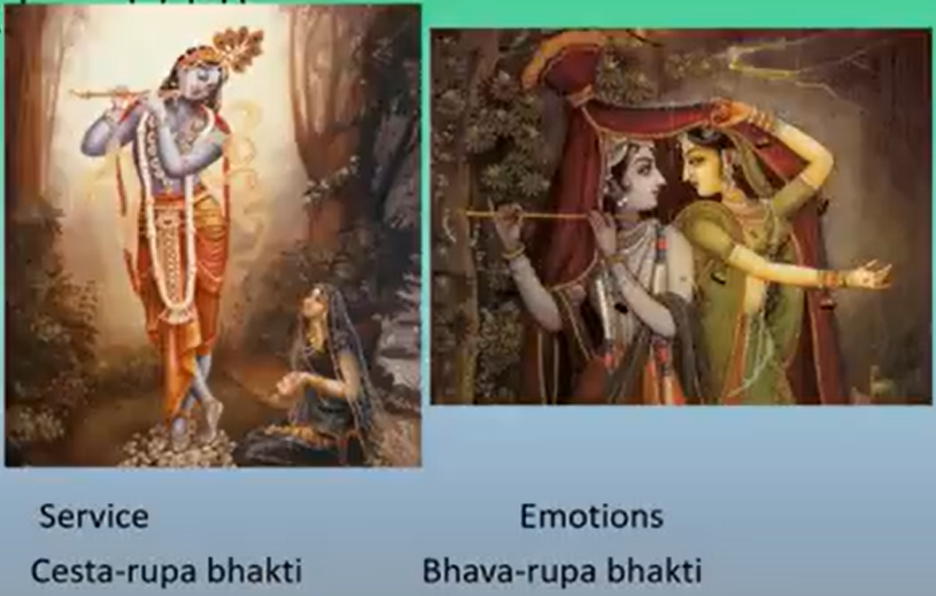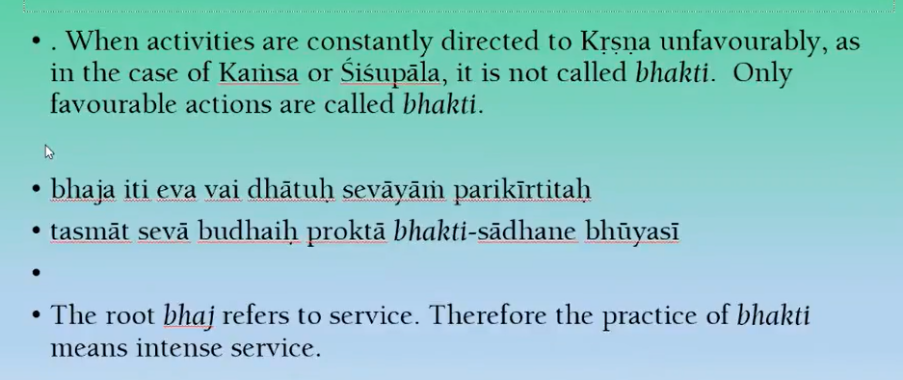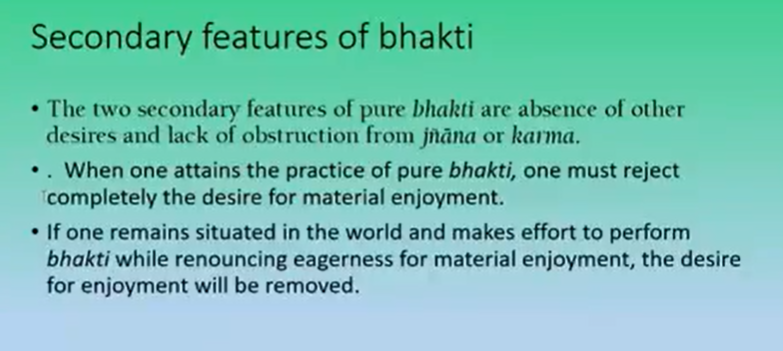Seminar on Bhakti Tattva Viveka | ISKCON Japan | HH Bhanu Swami Maharaj | 30th July 2018
nama om vishnu-padaya Kṛṣṇa-preshthaya bhu-tale
srimate bhaktivedanta-svamin iti namine
namas te sarasa vate deve gaura-vani-pracharine
nirvishesha-shunyavadi-pashchatya-desha-tarine
sri-Kṛṣṇa-chaitanya
prabhu Nityananda
sri-adwaita gadadhara
shrivasadi-gaura-bhakta-vrinda
Hare Krishna Hare Krishna Krishna Krishna Hare Hare
Hare Rama Hare Rama Rama Rama Hare Hare
This is a short work written by Srila Bhaktivinoda Thakur in Bengali. So he actually summarises a lot of what Rupa Goswami says in the Nectar of Devotion. He also adds a few of his own analysis in the process. So we have Caitanya Mahaprabhu who really didn’t write anything, but he empowered and instructed Rupa, Sanatana and others to compile and explain the process of bhakti. So in Vrindavan we have six Goswamis, of which we can say three or four wrote quite significant works. So Rupa Goswami made a very big contribution by writing this Bhakti-rasamrta-sindhu. This explains the nature of pure bhakti. It also discusses the different stages of bhakti. It also discusses the different types of bhakti, that’s Raganuga and Vaidhi Bhakti and in detail he describes rasa. Of course besides this, he wrote different plays and dramas. He also wrote Ujjvala-Nilamani, which is another book on rasa, but only Madhurya-rasa. His elder brother was Sanatana Goswami, so one of his major things is the Brhad-Bhagavatamrta , but this is mostly a story, two stories actually. The other work is Hari-bhakti-vilasa, which he along with Gopalabhata wrote, but this is mostly about deity workship. So Jiva Goswami was younger and he is the other great contributor, especially in philosophical works, one of his famous works is the Six Sandarbhas and two of those, Bhakti-Sandarbha and Priti-Sandarbha, deal with much of the same material as Bhakti-rasamrta-sindhu.
So after this, then we get a few hundred years later, Vishvanath Chakravarti Thakur, writing commentaries on Nectar of devotion and other works [Laughs] and right next to him was, at the same time almost, was Baladeva Vidyabhushana, who wrote many philosophical texts. Then we come to the modern era, and we find that Bhaktivinoda Thakur has written many many works as well. So many of these are explanations of the Goswamis’ works. Of course he also wrote original works, but in these works, he also explains the meaning of the Goswami works.
This work is very small, the bigger ones are like Jaiva dharma and Caitanya-Siksamrta, they are quite large works, but this one is very small little work [Laughs]. This work is called Bhakti-tattva-viveka. Viveka means analysing, discerning, trying to understand with intelligence. We have a famous person [Laughs], Vivekananda [Laughs], the bliss of Viveka, analysing things. So this is analysis of bhakti-tattva, which means the nature of bhakti or the truth about bhakti. So a lot of this follows the Nectar of devotion of Rupa Goswami. If you can’t go through Nectar of devotion because it’s too big and complicated, at least you study Bhakti-tattva-viveka and you’ll get the essence of bhakti. So the first important point is the definition of pure bhakti.This is important because if we don’t follow this particular definition and we do another type of bhakti, we get a different result. So the result of this is that by doing the sadhana with this definition, you get Prema and Rasa. If you do other types of bhakti, at best you can get a very, very weak form of Rasa.

So this is the definition, and it’s also found in the Caitanya Caritamrta, also Prabhupada quotes it in the commentary on the Bhagavatam, so it’s quite a famous definition. So the meaning of this is that this pure bhakti means uttama bhakti, that’s pure bhakti, it means cultivation of a relationship with Krishna which is favourable. So there are different types of relationships; we have some relationships, in which we establish affection, we have other relationships in which we establish hatred. So obviously bhakti does not mean anything to do with hatred, anukulya represents the favourable or affectionate relationship we’re trying to cultivate.
So this uttama bhakti may also be called nirmala bhakti, or nirguna bhakti, or amisra bhakti, or kevala bhakti, or akincana bhakti, these are different Sanskrit names for the same thing.

So we have two types of cultivation, Krishna anusilanam – favourable cultivation. One is cesta rupa, which means actions, and the other is bhava rupa, which means emotions. Of course, in sadhana bhakti, we emphasize the action, the cesta rupa. By doing that, we eventually get to the goal of that sadhana, which is called bhava bhakti. The main element of that bhava bhakti is a manifestation of bhava, a sthayi bhava.

So in bhava bhakti, we can perceive the Lord, but not only that, we have a particular relationship with the Lord. There could be five different types – Santa bhava, Dasya bhava, Sakhya bhava, Vatsalya bhava, or Madhurya bhava, of course, these are with Krishna. If it’s with Vishnu, you could only have Santa and Dasya [Laughs].

So when we get to that bhava stage, we have these different sthayi bhavas manifesting, so they’re also anusilanam, Krishna anusilanam, even though there’s no action. So this is another aspect of anusilanam, this very relationship that we have with the Lord.
Translator Devotee: Sthayi bhava and.. ?
HH Bhanu Swami Maharaj: Which one? What was that?
Translator Devotee: Sthayi bhava and another bhava ? Anusilanam.
HH Bhanu Swami Maharaj: So anusilanam consists of that sthayi bhava plus the other activities, cesta rupa. So demons also have a relationship with Krishna, but we don’t call that bhakti.

So here, Bhaktivinoda Thakur quotes a definition of bhakti by analysing the word ‘bhaj’. The root ‘bhaj’ refers to service. So it’s service to Krishna, and it should be favourable, liking Krishna and it may be either the service may simply be the bhava itself, the relationship, or it could be the act of doing things. So the phrase ‘Krishna anusilanam’ was used, so we could say, well, what about devotion to Narasimha or Rama, that’s not called uttama bhakti ? because it says Krishna anusilanam. So the answer is that the word Krishna anusilanam is used because Krishna includes all the other forms.

So you could do bhakti to Narasimhadeva or Vishnu or Rama or Varaha, and it could still be called bhakti or uttama bhakti. If we were to say bhakti means ‘Vishnu anusilanam’, then that would exclude Krishna because he has extra qualities which are not in Vishnu [Laughs].
So though we could choose any form of the Lord to do bhakti to, if we choose to do it to Krishna, we are more fortunate. The reason is, that though all the forms of God are actually one Bhagavan, Krishna manifests some extra qualities that are not in the other forms. So if we worship Krishna and realise Krishna, then we get a realisation of more bliss. So generally people will criticise ISKCON, Lord Caitanya’s movement, why only Krishna? So of course they will say, why not Ganesha? why not Durga Devi? why not Shiva? etc. So in answer to that, actually many of these forms are devata, they are not supreme, they are not Bhagavan. So actually only those who worship Vishnu or Rama or Narasimha are worshipping Bhagavan. So if people want to worship other forms of Bhagavan, we have no objection. No you can do it [Laughs], permitted. You can worship and attain Prema also. However, the ultimate bliss is less, that’s all. So all of these approved, authorised forms of Bhagavan are also, you can say is uttama bhakti.
We can also include devotees in this anusilanam cultivating relationship with devotees of Krishna or other forms of the Supreme Lord, its called Uttama Bhakti like Hanuman. So if we cultivate a relationship with Hanuman, it’s also uttama bhakti, even though it’s not Supreme Lord, Bhagavan. But of course, he’s related to Rama, so again[Laughs], it’s still related to Supreme Lord. But it also includes service to the devotees of the Lord, so uttama bhakti, Krishna anusilanam.

So, realisation of Bhagavan has two types. One is realising Aishwarya, the other is realising Madhurya. Aishwarya means power, and Madhurya means sweetness. So Aishwarya actually comes from Ishvara and Ishvara means one who controls [Laughs]. So, when the Lord manifests all powers, then he is the form of Narayan or Vishnu.
When the Lord manifests his sweetness, then it is Krishna. In the material world power is generally more attractive than sweetness. We appreciate leaders because they got power, not because of their sweetness [Laughs]. So, in the spiritual world, the opposite, the sweetness is higher than the power [Laughs]. Now, of course, you can choose either aspect to worship, it’s all bonafide bhakti.

Actually the whole of the second part of the Brhad Bhagavatmrta is the quest for –Gopa Kumara.—– He goes to all the places in the material world and he goes to the spiritual world, he goes to Siva Loka, then he goes to Vishnu Loka, Vaikunta , then he goes up to Ayodhya, then he goes to Dwaraka [Laughs] , finally he gets to Vrndavana, that’s the highest one.

So, in the very beginning of Nectar of Devotion, Rupa Goswami also explains this in this particular verse here, though the forms of Vishnu and Krishna are non-different according to the statements of scripture. Krishna’s form is shown to be superior, because of his rasas, which are endowed with the highest type of prema. So, the prema is lot more intense for Krishna.

So, in that definition, then we have some other aspects, we are just talking about Krishna anusilanam there. So, in the other part of the definition, the first line, we got this ‘anyābhilāṣitā-śūnyaṁ jñāna-karmādy-anāvṛtam’, these are called the secondary features of the definition. So, this means devoid of other desires, but it doesn’t mean no desires. So, we have a desire to please Krishna and serve Krishna that is the pure bhakti element. Other desires, other than pleasing Krishna, then that makes it impure bhakti. Normally, other desire means, we have a desire to get material enjoyment.

So, of course, we practise sadhana bhakti, we’re still in the material world. And the material attachments gradually reduce, it’s not suddenly you do bhakti and all the material attachments are gone. So, actually only in prema there is no more attachment at all. So, we may ask, well, we’re doing sadhana bhakti and we’re impure.ow can we do pure bhakti ,anyābhilāṣitā-śūnya bhakti, how is it possible?. However, in the Nectar of Devotion, when Rupa Goswami gives his definition, anyābhilāṣitā-śūnya, then he says it has three types, sadhana, bhava and prema. So, therefore, we can have uttama bhakti in sadhana as well.
So, the reason we call in sadhana bhakti, we call uttama bhakti is, because even though we do have material attachments, material desires, when we’re performing the bhakti, we renounce desires, we don’t ask Krishna for anything. Now, we’re not pure, of course, but in the performance of bhakti, we’re not expecting material enjoyment as a result of our bhakti, that’s all. So, therefore, we’re not 100% pure, we’ve got anarthas, material attachments etc. We perform our bhakti, we do not request Krishna for things, then, through that process, we get to bhava and we get to prema.
So, what happens if we do bhakti, but we have material [not audible], and we pray to Krishna, we chant Hare Krishna, we’re asking Krishna for material things, what happens? So, this is not uttama bhakti. It’s not anya abhilasitha sunya anymore. But, we can advance, we can progress upwards also and eventually, we can get rid of all the anarthas. We can surpass liberation and, we can even go to the spiritual world and, we can get a spiritual body. So, that much we can get but no prema [Laughs] or we get prema, but it is a weak santa rasa. So, santa rasa is defined as a neutral rasa, in which we don’t really directly serve the Lord. So, if we do bhakti, and we have our anarthas, but in our bhakti we reject those material requests, etc., then we can progress to prema otherwise, we don’t do that, and we are asking for material things all the time, then, we can go to the spiritual world, but the prema doesn’t develop. So, if we are practising bhakti, then the process of bhakti will eventually destroy these material attractions. We don’t have to practise other things like vairagya, jnana, and become like a yogi or whatever.

So, besides material enjoyment, the other desire would be desire for liberation, that impersonal liberation. So, people who are influenced by Tamo guna and Rajo guna are more likely to go for material desires [Laughs]. People who are in sattva guna are more likely to go for liberation [Laughs]. Of course, there are five types of liberation, there is Salokya going to the planet of the Lord, there is Sarsti getting powers like the Lord, Samipya being close to the Lord, and Sarupya getting a form like the Lord, so, these are acceptable within pure bhakti also. So if we desire happiness, we desire these things for our happiness and power, that is rejected [Laughs], not for ourselves. So, we can desire these things for the service of the Lord, that is permissible.

,
But those who are only interested in Prema and serving the Lord are not even interested in these types of liberation, they reject them. In that definition we have jnana karmadi anavrtam, it should not be covered by jnana or karma. So, these are descriptions of people doing sadhana bhakti. So, we have to protect the creeper of bhakti from the negative influences of karma, jnana, and other processes.

If jnana and karma and other things obstruct, then that plant of bhakti cannot grow. So, if the bhakti creeper cannot grow, it cannot get to the stage of nistha. If we don’t get to nistha, then we will have lots of unsteadiness and problems [Laughs]. So, that knowledge which obstructs bhakti is the impersonal jnana. That jnana, which is knowledge of the Lord and bhakti, that is part of bhakti, so that’s encouraged. And as for karma, obviously in devotional service we do activities, so we don’t avoid activities, we do activities.

So, we avoid those activities of the varnashrama system, which are contrary to bhakti, but if things in the varnashrama system are favourable to bhakti, we do them. So, therefore it says that jnana and karma should not obstruct the bhakti, if they don’t obstruct, we can do. So, that covers the definition of bhakti, that’s the first chapter of this.
Any questions?
Q & A
1) Question is not audible ?
So, varnashrama has all sorts of rules for the body, for keeping clean, so many things like that. It also has rules for raising families and interaction with family members. It has rules for how you relate to other people in society, etc. So, there are many different levels of rules. So, in doing bhakti, the bhakti rules are only concerned with relating to Krishna, they don’t mention anything about how you support your body, how you relate to your family at all [Laughs], so, what do we do? Everybody’s got a body; everybody’s living in a society. What rules do we follow? So, for instance, we have a body, and varnashrama has nice rules for taking a bath, for wearing clean cloth, and other things. So, this is bodily rules, bhakti doesn’t mention anything about that. So, in relation to the body, then, what does a devotee do? So, he follows the rules, he bathes according to the rules of varnashrama, he eats according to the rules of varnashrama, etc. but, he won’t follow those things where they start worshipping devatas and other things like that, which are contrary to bhakti.
Similarly, what do we do for family members? So, Varnashrama recommends we do samskaras. So we have marriage samskaras, if we only do bhakti, we have no marriage, we don’t say that [Laughs]. But, we have to have some marriage, so we follow varnashrama marriages [Laughs]. So, if there is worship of a devata, then we omit that portion [Laughs].
Devotee: What about the Gopis worship demigods like Katyayini etc ?
HH Bhanu Swami Maharaj: Oh, that is part of past times in the spiritual world, so that is not the same thing.
Devotee: So, we should not do ?
HH Bhanu Swami Maharaj: Yes obviously we are not at that level any way [Laughs]. Worship Krishna as the husband or something like that.
Devotee: Some devotees worshipping Lord Siva etc.
HH Bhanu Swami Maharaj: We can worship these as devotees of the Lord, no problem or, prema, and service in prema.
2) You have mentioned that Sthayi bhava appears at bhava stage, what about sanchari bhavas ?
Yeah. Well, sanchari bhavas also manifest within bhava and prema, but, they can’t exist unless we have a sthayi bhava. If you don’t have a relationship with Krishna, you can’t have these secondary bhavas like anxiety and worry, etc or sattvika bhavas, crying, etc unless we have the principle sthayi bhava relationship. So, the sthayi bhava in bhava stage will manifest either through Raganuga or through Vaidhi bhakti.
Devotee: Sanchari bhava means secondary rasa ?
HH Bhanu Swami Maharaj: No, it’s part of rasa. So, the sthayi bhava is there, and we have other elements, vibhava, anubhava, sattvika bhava, and sanchari bhavas, five elements mix together, it’s called rasa.
Devotee: Sanchari bhava means?
HH Bhanu Swami Maharaj: Minor emotions, like worry. So, some of these become secondary rasas, like fear. If they prolong for some time, then they become a secondary rasa, but the secondary rasas cannot exist unless we have the main rasa [Laughs]. Of course, in Kamsa, we get the pure rasa, without the main rasa [Laughs]. So, it’s not called real, it’s not a real secondary rasa.
3) You mentioned in Uttama bhakti establishing relationship with devotees, you gave example of Hanuman, what about relationship with sadhakas ?
Well, we can do that, but it’s always secondary to establishing a relationship with Krishna. In other words, why do we have a relationship with devotees? because the devotees are related to Krishna, so it’s all related to Krishna. We can’t do it without the relationship with Krishna. We can all say this is all classified as Sat sanga, its not really rasa, of course you can say ok in the spiritual world there is rasa between the cowherd boys, in a sense, because it’s related to Krishna, they have a relationship with each other. So, it’s secondary to the relationship with Krishna.
Devotee: Relationship between Siksha Guru and Diksha Guru?
HH Bhanu Swami Maharaj: . Yeah, so while we have that relationship, because it’s also related to Krishna [Laughs], obviously guru is related to Krishna, so therefore that’s why we respect the guru. Just as we respect devotees, and we respect senior devotees, and we get instructions from them. So, all because they’re related to Krishna, and through them we get the shakti of bhakti.
Devotee: Can we do kirtan for a devotee [Not clear]?
HH Bhanu Swami Maharaj: Yeah, so Rupa Goswami says all the angas of bhakti in relation to Krishna can also be practised in relation to the devotees. So we can do kirtan of a devotee, we can hear about devotees, and it’s all considered bhakti also.
Devotee: We can’t divide it ?
HH Bhanu Swami Maharaj: Yeah, we can’t divide it. It’s obviously related [Laughs] to the main element of Krishna, but the devotees and Krishna are inseparable. The basis of that relationship with the guru is because he’s related to Krishna [Laughs]. If he has got a relationship with the guru, that relationship becomes material.
Hare Krsna !
Devotees: HH Bhanu Swami Maharaj Ki.. Jai !!


